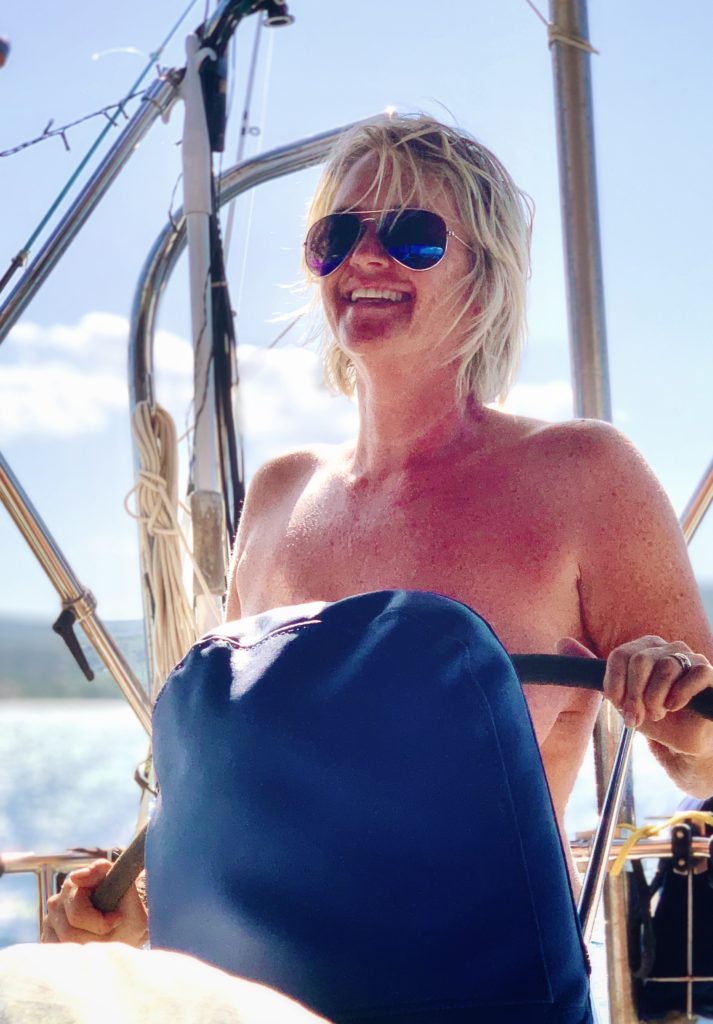Living the Dream: 40 Reasons Why Living on a Sailboat Full-Time is the Ultimate Lifestyle

Living the Dream: 40 Reasons Why Living on a Sailboat Full-Time is the Ultimate Lifestyle
Living on a sailboat full-time is a dream for many people, and for those who have made the leap, it can be a life-changing experience. While it certainly isn’t for everyone, there are countless benefits to living on a sailboat full-time. Here are 40 of the top benefits:
- Adventure – Living on a sailboat full-time provides endless opportunities for adventure. You can explore new places, meet new people, and experience life in a way that is completely different from anything you’ve ever known.
- Simplicity – Living on a sailboat full-time means living a simpler life with fewer possessions and less clutter. It can be a refreshing change from the fast-paced, consumer-driven lifestyle that is so common in modern society.
- Freedom – Living on a sailboat full-time gives you the freedom to go where you want, when you want. You can explore new places, chase the weather, and set your own schedule.
- Connection to Nature – Living on a sailboat full-time puts you in direct contact with nature on a daily basis. You’ll be able to enjoy stunning sunsets, clear water, and the sound of the waves lapping against the hull.
- Minimal Carbon Footprint – Living on a sailboat full-time means living a low-impact lifestyle with a minimal carbon footprint. You’ll be using wind power to travel and can generate your own electricity with solar panels and wind turbines.
- Flexibility – Living on a sailboat full-time means you can easily relocate to a new destination if you desire. You can move with the seasons, explore new areas, and experience new cultures.
- Cost Savings – Living on a sailboat full-time can be significantly less expensive than living on land. You’ll save money on rent or mortgage payments, property taxes, and utilities.
- Self-Sufficiency – Living on a sailboat full-time requires you to be more self-sufficient. You’ll need to generate your own power, catch your own food, and take care of your own repairs.
- Minimalism – Living on a sailboat full-time requires you to live a minimalist lifestyle. You’ll need to be intentional about what possessions you bring on board and what you leave behind.
- Health and Fitness – Living on a sailboat full-time can be great for your health and fitness. You’ll be more active, spending more time outside, and enjoying fresh air and sunshine on a daily basis.

Are you sold yet? Read on for 30 more reasons for living on a sailboat full-time…
- Reduced Stress – Living on a sailboat full-time can be a great way to reduce stress. You’ll be living a simpler, slower-paced life and can focus on what’s truly important.
- Stronger Relationships – Living on a sailboat full-time can help you build stronger relationships with those around you. You’ll be spending more time together, working together as a team, and enjoying new experiences together.
- Independence – Living on a sailboat full-time means being more independent. You’ll need to rely on your own skills and resources to solve problems and overcome challenges.
- New Skills – Living on a sailboat full-time can help you develop new skills, such as sailing, navigation, and boat maintenance.
- Increased Creativity – Living on a sailboat full-time can be a great way to increase your creativity. You’ll be living in a small space and will need to find creative solutions to problems.
- Sense of Community – Living on a sailboat full-time can help you feel a sense of community with other boaters. You’ll be part of a unique group of people who share a common interest.
- Unique Lifestyle – Living on a sailboat full-time is a unique lifestyle that can be a great conversation starter and can help you stand out from the crowd.
- Travel Opportunities – Living on a sailboat full-time opens up a whole new world of travel opportunities. You can explore new coastlines, visit remote islands, and discover hidden coves that are only accessible by boat.
- Sense of Accomplishment – Living on a sailboat full-time can give you a sense of accomplishment that comes from being self-sufficient and mastering the skills required to live on a boat.
- Intimacy with Nature – Living on a sailboat full-time allows you to be up close and personal with nature. You can watch dolphins swim by, observe sea birds in their natural habitat, and even catch your own fish for dinner.
- Adaptability – Living on a sailboat full-time requires you to be adaptable and flexible. You’ll need to be able to adjust to changing weather conditions, repair equipment on the fly, and deal with unexpected situations.
- Unique Work Opportunities – Living on a sailboat full-time can open up unique work opportunities, such as working as a charter captain or crew member on a larger yacht.
- Connection to History – Living on a sailboat full-time can help you feel connected to the history of sailing and maritime culture. You’ll be carrying on a tradition that dates back thousands of years.
- Minimal Environmental Impact – Living on a sailboat full-time means having a minimal impact on the environment. You’ll be using renewable energy sources and not contributing to the pollution that is so common on land.
- Mindfulness – Living on a sailboat full-time can help you cultivate a sense of mindfulness and presence. You’ll be living in the moment and enjoying the simple pleasures of life.
- Connection to the Ocean – Living on a sailboat full-time can give you a deeper connection to the ocean and its inhabitants. You’ll be more aware of the tides, currents, and weather patterns, and will be able to observe marine life up close.
- Improved Communication – Living on a sailboat full-time can help you improve your communication skills. You’ll need to communicate effectively with your crew, other boaters, and marina staff.
- Increased Confidence – Living on a sailboat full-time can help you develop increased confidence in your own abilities. You’ll be mastering new skills and overcoming challenges on a daily basis.
- Sense of Adventure – Living on a sailboat full-time can help you cultivate a sense of adventure that is often missing in modern life. You’ll be exploring new places and experiencing new things on a regular basis.
- Connection to the Weather – Living on a sailboat full-time can help you feel more connected to the weather and the natural world. You’ll be more aware of the wind, rain, and sun, and how they affect your daily life.
- Increased Creativity – Living on a sailboat full-time can inspire increased creativity in all aspects of your life. You’ll be living in a unique environment that can spark new ideas and ways of thinking.
- Enhanced Self-Discovery – Living on a sailboat full-time can help you discover new things about yourself and your own capabilities. You’ll be forced to confront your fears and limitations, and will discover strengths and skills you didn’t know you had.
- Freedom from Materialism – Living on a sailboat full-time means being free from the pressures of materialism and consumer culture. You’ll be able to focus on experiences and relationships, rather than accumulating possessions.
- Connection to the Night Sky – Living on a sailboat full-time can give you a deeper connection to the night sky. You’ll be away from the lights of the city and can enjoy a clear view of the stars and constellations.
- Sense of Peace – Living on a sailboat full-time can help you cultivate a sense of peace and tranquility. You’ll be away from the noise and stress of the city, and will be able to appreciate the simple pleasures of life.
- Improved Health – Living on a sailboat full-time can have positive effects on your health. You’ll be more physically active, spending time swimming, snorkeling, and exploring new places. You’ll also have access to fresh air and sunshine on a daily basis.
- Community – Living on a sailboat full-time can help you become part of a community of like-minded individuals. You’ll meet other boaters in marinas and anchorages, and can form lasting friendships with people from all over the world.
- Learning Opportunities – Living on a sailboat full-time means constantly learning new things. You’ll be learning about sailing, navigation, weather patterns, and marine life, as well as improving your cooking and maintenance skills.
- Reduced Cost of Living – Living on a sailboat full-time can be a more affordable way of life than living on land. You won’t have to pay rent or a mortgage, and can save money on utilities and transportation.
- Increased Appreciation for Life – Living on a sailboat full-time can help you develop a deeper appreciation for life and the world around you. You’ll be living in the moment and experiencing new things on a daily basis, and will come to appreciate the simple pleasures of life.
Living on a sailboat full-time is not for everyone, but for those who are drawn to this lifestyle, it can be a truly rewarding and fulfilling way of life. From the sense of adventure and connection to nature, to the community and learning opportunities, there are countless benefits to living on a sailboat full-time. Whether you’re considering this lifestyle as a temporary break from the rat race, or as a permanent way of life, there’s no denying the unique and special experience that living on a sailboat can offer.

So…I’m sure there are 40 more things that can be added to this list. What can you add? Leave a comment below.
What are the reasons you love the sailing life?
Please leave them in the comments below.
Fair winds and calm seas
Carl and Jenny
If you enjoyed this blog post please check out our Freebies page where you can download other guides, and if you’re feeling really good consider having a look at our Support us page.
The Importance of a Thorough Pre-Passage Checklist: A Sailor’s Perspective
Sailing can be an exciting and rewarding experience, but it’s important to take safety seriously. Before setting sail, it’s essential to conduct a pre-passage check to ensure that everything is in good working order and that you have all the necessary equipment on board. In this blog post, we’ll go over some of the key items to include on your pre-passage checklist.
1. Check the weather
Before setting sail, it’s important to check the weather forecast. Make sure to look at both the current conditions and the forecast for the duration of your planned voyage. If the forecast indicates strong winds or rough seas, you may want to reconsider your plans. Additionally, make sure you have a way to receive weather updates while at sea.
2. Inspect the hull
Before leaving the dock, take a close look at the hull of your boat. Look for any cracks, blisters, or other damage that could compromise the boat’s integrity. Pay particular attention to the waterline, where damage is more likely to occur. If you notice any damage, have it repaired before setting sail.
3. Check the rigging
Inspect the rigging of your boat, including the mast, shrouds, and stays. Look for any signs of wear or damage, such as frayed or kinked lines. Make sure all connections are secure and that all lines are properly tensioned. If you notice any problems, address them before leaving port.
4. Check the sails
Inspect your sails for any signs of wear or damage, such as tears, holes, or worn areas. Check that all battens are securely in place and that the sail is properly rigged. Make sure you have all necessary sails on board for the conditions you expect to encounter.
5. Check the engine
Before setting sail, check the engine to ensure that it’s in good working order. Check the oil level, coolant level, and fuel level. Make sure all belts are properly tensioned and that the impeller is in good condition. Start the engine and let it run for a few minutes to make sure it’s operating properly.
6. Check the navigation equipment
Make sure all navigation equipment is in good working order. This includes the GPS, compass, charts, and any other navigation aids you plan to use. Check that all batteries are fully charged and that you have backups in case of equipment failure.
7. Check the safety equipment
Before setting sail, make sure you have all necessary safety equipment on board. This includes life jackets, flares, fire extinguishers, and first aid supplies. Check that all equipment is in good working order and that you have enough supplies for the length of your voyage.
8. Check the communication equipment
Make sure you have all necessary communication equipment on board, such as a VHF radio and a satellite phone. Check that all equipment is in good working order and that you have backup communication options in case of equipment failure.
9. Check the provisions
Make sure you have enough food, water, and supplies on board for the length of your voyage. Check that all food is properly stored and that you have enough cooking fuel. Make sure you have a plan for disposing of waste while at sea.
10. Review your plan
Before setting sail, review your passage plan to ensure that it’s safe and feasible. Make sure you have a backup plan in case of unexpected weather or other challenges. Ensure that everyone on board knows the plan and their roles in case of emergency.
Remember to prioritize safety above all else and to never hesitate to call for help if you need it. With the right preparation, sailing can be a rewarding and enjoyable experience for everyone on board.
11. Check the anchoring equipment
Anchoring is an essential part of sailing, especially if you plan to spend the night at anchor. Before leaving port, make sure you have all necessary anchoring equipment on board, including anchors, chain, and line. Inspect all equipment for wear or damage and make sure you have enough line to anchor in the depths you plan to encounter.
12. Check the bilge pump
A functioning bilge pump is essential to keep water out of the boat. Before leaving port, make sure your bilge pump is in good working order. Check that it turns on automatically and that the float switch is properly functioning. Make sure you have a backup manual pump in case of electrical failure.
13. Check the battery power
Before setting sail, check the battery power of your boat. Make sure all batteries are fully charged and that you have enough power to run all necessary equipment while at sea. Bring extra batteries or a generator if necessary.
14. Check the head (toilet)
The head is an essential component of any boat, especially for longer voyages. Before leaving port, check that your head is in good working order. Make sure you have enough toilet paper and a plan for disposing of waste while at sea.
15. Check the fuel and water tanks
Make sure you have enough fuel and water on board for the length of your voyage. Check that all tanks are full and that you have enough fuel to operate the engine and generator. If you plan to rely on water catchment, make sure you have enough capacity to catch and store enough water.
16. Check the weather forecast
Before setting sail, check the weather forecast for the duration of your voyage. Make sure you understand the conditions you can expect to encounter and adjust your plans accordingly. If you’re not experienced in reading weather forecasts, consider consulting a professional or experienced sailor to help you interpret the information.
17. Check the communication equipment
Effective communication is essential for safety while sailing. Before leaving port, make sure all communication equipment on board is in good working order. Test your VHF radio and make sure you have backup communication options like a satellite phone or handheld VHF.
18. Check safety equipment
Make sure you have all necessary safety equipment on board, including life jackets, flares, and a first aid kit. Inspect all equipment for wear or damage, and make sure everyone on board knows how to use it in case of an emergency.
19. Check navigation equipment
Navigational equipment is essential for safe sailing, especially if you’re venturing into unfamiliar waters. Before leaving port, check that all navigational equipment is in good working order. Make sure you have charts, a compass, and a GPS, and make sure everyone on board knows how to use them.
20. Check the crew
Last but not least, make sure your crew is ready and prepared for the voyage ahead. Conduct a safety briefing before leaving port, and make sure everyone knows their roles and responsibilities on board. Make sure everyone on board is comfortable and familiar with the boat and its equipment, and that everyone is well-rested and prepared for the journey.
By following these pre-passage check list steps, you can ensure that you and your crew have a safe and successful voyage. Remember, preparation is key when it comes to sailing, and taking the time to conduct a thorough pre-passage check can help prevent accidents and ensure a memorable and enjoyable experience.
Is there something else you check as part of your pre-passage checks before you go out? Let us know in the comments below.
Fair winds and calm seas,
Carl and Jenny
If you enjoyed this blog post please check out our Freebies page where you can download other guides, and if you’re feeling really good consider having a look at our Support us page.
Surviving the Unexpected: Coping with Emergencies Onboard Your Boat
1. Equipment failure
2. Man overboard
3. Weather-related emergencies
4. Medical emergencies
5. Collision or grounding
6. Fire
Carl and Jenny
If you enjoyed this blog post please check out our Freebies page where you can download other guides, and if you’re feeling really good consider having a look at our Support us page.
The Ultimate Boat Prep Guide: 7 Tips to Wow Your Guests!
Welcome aboard!
In this week’s Patron only J-Log, I’m going to share some fantastic tips that will wow your guests.

Are you ready to impress your guests with a perfectly prepared boat? Look no further! In this must-watch video, we bring you the ultimate boat prep guide packed with 7 tips that will leave your guests in awe. From creating a welcoming ambiance to ensuring their safety and comfort, we’ve got you covered.
Join us as we dive into the art of boat preparation, transforming your vessel into a luxurious haven that will rival a 5-star hotel. Discover the secrets to decluttering and organizing your boat, making every corner a picture of pristine beauty. You’ll learn the importance of stocking up on provisions that cater to your guests’ preferences, ensuring that no craving goes unanswered during their stay.
But it doesn’t stop there! Safety is a top priority, and our experts will guide you through essential checks of life jackets, fire extinguishers, and other safety equipment, guaranteeing peace of mind for you and your guests. We’ll also show you how to set up inviting seating areas on the deck, complete with shaded spaces for relaxation and breathtaking views.
Want your guests to feel pampered? We’ve got you covered. Discover our tips for creating cozy and inviting guest cabins, complete with fresh linens and personal touches that will make your guests feel truly special. Plus, we’ll help you plan the perfect itinerary, sharing essential information about navigation rules and safety procedures, ensuring a smooth and enjoyable journey for everyone.
Don’t forget the entertainment! We’ll reveal creative options to keep your guests entertained, whether it’s music, books, board games, or water sports equipment. And of course, we’ll show you how to set a stunning table in the dining area, complete with elegant tableware and charming decorations, turning mealtime into a memorable experience.
Get ready to become the ultimate boat host with our expert tips and tricks. Don’t miss out on this essential guide to wowing your guests and creating unforgettable moments onboard.
If you’d like to watch this and over 250 other Patron only videos head over to our Patreon channel at Patreon.com/carlandjenny from less than the cost of a cup of coffee per month. We publish at least two Patron only videos per week as well as other posts.
Don’t forget to like, comment, and subscribe for more sailing tips and adventures! Hit the notification bell 
Jenny
Sailing the World on a Budget: How to Fund and Live a Nomadic Sailing Lifestyle
1. Live frugally
2. Work remotely
3. Charter your boat
4. Teach sailing
5. Blogging and Social Media
6. Find seasonal work
“Surviving the Unexpected: Coping with Emergencies Onboard Your Boat”
Carl and Jenny
If you enjoyed this blog post please check out our Freebies page where you can download other guides, and if you’re feeling really good consider having a look at our Support us page.
The Benefits of Naturism on Boats: Exploring the Freedom and Wellness of a Clothing-Optional Lifestyle at Sea
Well it’s no secret that we are both naturists. We became “open” about it a few years ago. We were quite shocked to find out that quite a few of our friends were also naturists but didn’t like to admit to it. I (Carl) wrote a piece about how it helped me some time ago when I was diagnosed with complex PTSD. The post is over on our Patron page.

Naturism may shock some people, some may think it’s vulgar and dirty, others may think there’s some perverse connotation to it, but for many, the biggest survey ever into naturism has found 14% of people now describe themselves as naturists or nudists: an estimated 6.75 million – or one in seven people.
Naturism, or the practice of being naked in social and recreational settings, has been around for centuries. It’s a lifestyle that promotes body positivity, acceptance, and the freedom to express oneself without judgment. For those who love being on the water, naturism on boats is a natural extension of this lifestyle that can offer a range of benefits for both physical and mental wellbeing.
First and foremost, naturism on boats is great for physical health. Being naked allows the skin to breathe and soak up essential Vitamin D from the sun, which is important for maintaining strong bones and a healthy immune system. Vitamin D also helps to reduce the risk of diseases such as cancer, heart disease, and multiple sclerosis. Additionally, being naked on a boat can help to regulate body temperature, making it easier to stay cool in the hot sun and avoid overheating.
Beyond the physical benefits, naturism on boats can also have a positive impact on mental health. For many people, being naked in social settings can be a liberating experience that promotes body positivity and self-acceptance. Naturism on boats can provide a sense of freedom and connection to nature that can be difficult to find in our modern, technology-driven world. Being surrounded by the natural beauty of the ocean, the wind in your hair, and the sun on your skin can be a transformative experience that promotes relaxation, mindfulness, and a sense of calm.
Naturism on boats can also foster a sense of community and social connection. By participating in a naturist boating group or club, you can meet like-minded individuals who share your passion for being on the water and embracing a clothing-optional lifestyle. Naturism on boats can provide a sense of camaraderie and belonging that can be difficult to find in traditional social settings.
Another benefit of naturism on boats is the sense of adventure and exploration it can provide. Boating allows you to travel to new destinations, explore hidden coves and beaches, and experience the beauty of the ocean in a way that few other activities can match. Naturism on boats can provide an added sense of freedom and adventure, allowing you to connect with nature and explore new horizons without the constraints of clothing or societal norms.
Of course, as with any activity, it’s important to take proper safety precautions when engaging in naturism on boats. Make sure to wear appropriate sunscreen and protective gear, and be aware of potential hazards such as strong currents, wildlife, and inclement weather. Additionally, it’s important to respect the privacy and boundaries of others when engaging in naturism on boats, and to seek out like-minded individuals and groups who share your values and interests.
In conclusion, naturism on boats can offer a range of benefits for both physical and mental wellbeing. From promoting body positivity and self-acceptance to fostering a sense of community and adventure, naturism on boats can be a transformative experience that promotes relaxation, mindfulness, and a sense of calm. So whether you’re a seasoned naturist or just curious about exploring a clothing-optional lifestyle, consider giving naturism on boats a try and experience the joy and wellbeing benefits for yourself.
Let us know in the comments your thoughts about naturism in general. Are you a naturist? Are you against it? Be interested to hear your thoughts.
Next week: “Sailing the World on a Budget: How to Fund and Live a Nomadic Sailing Lifestyle”
Fair winds and calm seas
Carl and Jenny
If you enjoyed this blog post please check out our Freebies page where you can download other guides, and if you’re feeling really good consider having a look at our Support us page.
Med Mooring Made Easy!
Welcome aboard!
In this week’s Patron only J-Log, I’m going to share some fantastic tips that will make stern-to-mooring a breeze.

Welcome aboard! I’m thrilled to have you here as we embark on a delightful journey to explore the ins and outs of stern-to-mooring. Now, I know what you’re thinking: “Whoa, that sounds like a whole lot of maneuvering!” But don’t you worry, my nautical friends, because I’ve got your back, or should I say, your stern!
Today, I’m going to share some fantastic tips that will make stern-to-mooring a breeze. We’ll tackle it with a sprinkle of humor, a pinch of laughter, and a boatload of confidence. So grab your favorite deck chair, find a cozy spot, and get ready to navigate these waters like a pro!
Picture this: you’re approaching the dock, the sun glistening on the water’s surface, and a gentle breeze tousling your hair. As you gracefully glide towards your mooring spot, you’ll be armed with the knowledge and techniques to make it a flawless docking experience. Believe me, when you master stern-to-mooring, you’ll be the envy of all your fellow boaters.
But hey, we won’t keep you waiting any longer! Get ready to discover those handy tips that will make stern-to-mooring a piece of cake. So, let’s set sail on this adventure together, blending the thrill of learning with the joy of being out on the open water. Get those sea legs ready, my friends, because we’re about to dive into the art of stern-to-mooring like never before!
So, tighten those life vests, adjust your captain’s hat, and prepare to become the ultimate stern-to-mooring maestro. Our ship is about to set sail into uncharted waters of knowledge and skill. Get ready to rock those mooring lines like a boss and impress everyone who sets eyes on your docking prowess.
Without further ado, let’s weigh anchor and delve into these marvelous tips that will have you docking with finesse in no time! Are you ready to become the star of the marina? Let’s hoist those sails and embark on this unforgettable journey of stern-to-mooring mastery!
If you’d like to watch this and over 250 other Patron only videos head over to our Patreon channel at Patreon.com/carlandjenny from less than the cost of a cup of coffee per month. We publish at least two Patron only videos per week as well as other posts.
Don’t forget to like, comment, and subscribe for more sailing tips and adventures! Hit the notification bell 
Jenny
If you enjoyed this blog post please check out our Freebies page where you can download other guides, and if you’re feeling really good consider having a look at our Support us page.
The Healing Power of Sailing: Reducing Stress and Enhancing Wellbeing Through the Art of Seamanship
The Healing Power of Sailing
Sailing is a wonderful activity that provides a sense of freedom, adventure, and excitement. The wind in your hair, the sound of the waves, and the feel of the boat gliding through the water can be truly exhilarating. But beyond the thrill of the experience, sailing has a range of benefits for your wellbeing, from reducing stress to improving mental and physical health.
One of the key benefits of sailing
One of the key benefits of sailing is its ability to reduce stress. Sailing provides a sense of escape from the pressures of daily life, allowing you to disconnect from work and other responsibilities and immerse yourself in the present moment. Being out on the water also provides a sense of calm and tranquility, helping to lower stress levels and promote relaxation.
In addition to reducing stress, sailing can also have a positive impact on mental health. The experience of being out on the water can help to boost mood and alleviate symptoms of depression and anxiety. The combination of fresh air, natural surroundings, and physical activity can help to release endorphins and other mood-boosting chemicals in the brain, leading to an overall sense of wellbeing.
Sailing can also be a great way to improve physical health
Sailing can also be a great way to improve physical health. Sailing requires a range of physical skills, from balancing on a moving deck to hoisting sails and maneuvering the boat. These activities provide a full-body workout that can help to build strength, flexibility, and cardiovascular fitness.
Sailing can also be a great way to get outside and enjoy nature. Being out on the water provides an opportunity to connect with the natural world and appreciate its beauty and tranquility. Whether it’s watching a sunset over the water or spotting wildlife in their natural habitat, sailing can be a great way to experience the outdoors and cultivate a sense of wonder and awe.
Another benefit of sailing is its ability to promote social connection and community.
Another benefit of sailing is its ability to promote social connection and community. Sailing often involves working as part of a team, whether it’s with friends, family, or fellow sailors. This collaboration and shared experience can help to build relationships and foster a sense of community and belonging.
Sailing can also be a great way to challenge yourself and push your limits
Sailing can also be a great way to challenge yourself and push your limits. Whether it’s learning a new sailing technique, navigating challenging weather conditions, or competing in a regatta, sailing provides a range of opportunities to set goals and achieve personal growth.
Overall, sailing is a wonderful activity that provides a range of benefits for your wellbeing. From reducing stress and improving mental health to promoting physical fitness and fostering social connection, sailing has something to offer for everyone. So whether you’re an experienced sailor or a first-time adventurer, consider giving sailing a try and experience the joy and wellbeing benefits for yourself.
Of course, as with any activity, it’s important to take proper safety precautions when sailing. Make sure to familiarize yourself with the boat and sailing equipment, wear appropriate safety gear, and be aware of weather conditions and other potential hazards. By prioritizing safety and responsibility, you can enjoy all the benefits of sailing while also ensuring a safe and enjoyable experience for yourself and those around you.
In conclusion
In conclusion, sailing is a wonderful activity that provides a range of benefits for your wellbeing. From reducing stress and improving mental health to promoting physical fitness and fostering social connection, sailing has something to offer for everyone. So whether you’re looking for a new adventure, a way to connect with nature, or simply a way to relax and unwind, consider giving sailing a try and experience the joy and wellbeing benefits for yourself.
Next week; “The Benefits of Naturism on Boats: Exploring the Freedom and Wellness of a Clothing-Optional Lifestyle at Sea“. Be sure to join us then.
Fair winds and calm seas
Carl and Jenny
f you enjoyed this blog post please check out our Freebies page where you can download other guides, and if you’re feeling really good consider having a look at our Support us page.
Renaming Your Boat: Tips and Traditions for a Successful Ceremony
Hi and welcome to Carl and Jenny Sailing Adventures! In today’s Patron only D-Log video, we’re going to discuss the process of renaming a boat and share some tips for a successful renaming ceremony. 🌊⛵

We’ll cover the importance of choosing a meaningful and appropriate new name for your vessel, as well as how to plan a memorable and enjoyable renaming ceremony that incorporates traditional rituals and your own personal touches. 🎉
Additionally, we’ll talk about the significance of involving friends, family, and fellow sailors in the celebration, creating lasting memories and strengthening the bond between you, your boat, and your boating community. 🥂👨👩👧👦
Join us as we embark on this exciting journey and learn how to give your boat a fresh start with a new name that reflects your personality and passion for sailing.
If you’d like to watch this and over 200 other Patron only videos head over to our Patreon channel at Patreon.com/carlandjenny from less than the cost of a cup of coffee per month. We publish at least two Patron only videos per week as well as other posts.
Don’t forget to like, comment, and subscribe for more sailing tips and adventures! Hit the notification bell 
Carl and Jenny
If you enjoyed this blog post please check out our Freebies page where you can download other guides, and if you’re feeling really good consider having a look at our Support us page.
5 Tips for extras you may need when antifouling your boat
Ahoy, fellow sailors! 🌊⛵️ In today’s Patron only J-Log video, we’re sharing our top 5 tips for extras when antifouling your boat, ensuring it stays in tip-top shape and ready for your next adventure. Join Jenny as we dive into the world of boat maintenance and protection.
In this video, we’ll cover items you might not consider prior to antifouling:
- Choosing a foldable seat 🎨🛥️
- Properly protecting your boat’s hull for antifouling application, get some tie wraps 🧹🔧
- Techniques for protectio, Sticks and cardboard. 🖌️🔄
- Cleaning products ⚓️📆
- Music/radio/podcasts – entertainment. 🌱🌍
If you’d like to watch this and over 200 other Patron only videos head over to our Patron channel at Patreon.com/carlandjenny from less than the cost of a cup of coffee per month. We publish at least two Patron only videos per week as well as other posts.
Don’t forget to like, comment, and subscribe for more sailing tips and adventures! Hit the notification bell 🔔 to stay updated on our latest content. Let’s set sail and make this summer one to remember! ⛵️🌞🌴
Carl and Jenny
If you enjoyed this blog post please check out our Freebies page where you can download other guides, and if you’re feeling really good consider having a look at our Support us page.




